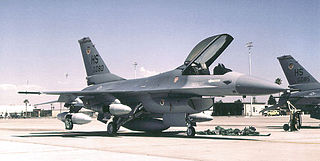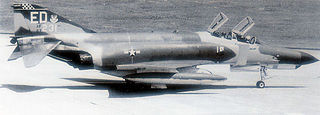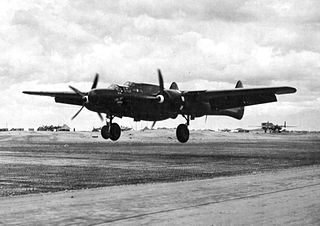
The 67th Cyberspace Operations Group is a unit of the 67th Cyberspace Wing. Headquartered on Kelly Field Annex's Security Hill, the group is an Air Force information operations unit.

The 353rd Special Operations Wing is an operational unit of the United States Air Force Special Operations Command, stationed at Kadena Air Base, Japan.

The 308th Fighter Squadron is an active United States Air Force unit. It is part of the 56th Operations Group at Luke Air Force Base, Arizona, where it trains pilots on the Lockheed Martin F-35A.

The 108th Operations Group is a unit of the 108th Wing of the New Jersey Air National Guard, one of the many units stationed at the McGuire AFB entity of Joint Base McGuire-Dix-Lakehurst, New Jersey. If activated to federal service with the U.S. Air Force, the group is gained by Air Mobility Command.

The 54th Tactical Fighter Wing is an inactive United States Air Force unit. Its last assignment was with the Pacific Air Forces Fifth Air Force, at Kunsan Air Base, South Korea where it was inactivated on 31 October 1970.

The 418th Test and Evaluation Squadron is an active United States Air Force unit assigned to the 53rd Test and Evaluation Group, and stationed at Davis-Monthan Air Force Base, Arizona, where it was activated on 1 October 2021.

The 547th Intelligence Squadron is an active United States Air Force (USAF) unit. It is assigned to the 365th Intelligence, Surveillance and Reconnaissance Group, stationed at Nellis Air Force Base, Nevada. The squadron serves as the USAFs center for adversary tactics analysis; develops intelligence threat training programs; defines potential threats to the US, provides intelligence support to Air Combat Command's test and evaluation programs and live-fly exercises.

The 309th Air Division is an inactive United States Air Force organization. Its last assignment was with Continental Air Command, assigned to Twelfth Air Force at Hensley Field, Texas. It was inactivated on 27 June 1949.

The 6th Air Intelligence Squadron is an inactive unit of the United States Air Force. Its last assignment was with Seventh Air Force, stationed at Osan Air Base, Korea. It was inactivated in 1993. The unit was originally established at Army Air Base, Colorado Springs, Colorado as the 6th Photographic Group on 5 February 1943, under the command of Lt Waymond Davis. Later that year, the unit was redesignated the 6th Reconnaissance Group and deployed to the southwest Pacific as a component of the Fifth Air Force.

The 460th Test and Evaluation Squadron is an active United States Air Force unit. It was previously assigned to Tactical Air Command's 325th Fighter Weapons Wing at Tyndall Air Force Base, Florida, where it was inactivated on 15 October 1982. On 11 August 2023, it was reactivated and assigned to the 926th Operations Group, 926th Wing at Nellias AFB, Nevada.

The 64th Bombardment Squadron is an inactive United States Air Force unit that was last assigned to the 43rd Bombardment Wing at Little Rock Air Force Base, Arkansas, where it was inactivated on 31 January 1970.

The 65th Special Operations Squadron is an Air Force Special Operations Command unit which flies the General Atomics MQ-9 Reaper at Hurlburt Field, Florida. The squadron was first activated as the 65th Bombardment Squadron in January 1941, one of the original squadrons of the 43rd Bombardment Group. Following the attack on Pearl Harbor, the squadron participated in antisubmarine patrols until January 1942, when it moved to Australia and the Southwest Pacific Theater. It moved forward with US forces through New Guinea and the Philippines, moving to Ie Shima shortly before V-J Day for operations against Japan. It earned two Distinguished Unit Citations and a Philippine Presidential Unit Citation for combat operations. During this period, a crew from the 65th became the most decorated aircrew in United States history, when their B-17 fought off twenty Japanese fighters during a photo reconnaissance mission. The squadron was inactivated in the Philippines in April 1946.

The 403d Bombardment Squadron is an inactive United States Air Force unit. It was last assigned to the 43rd Bombardment Wing at Carswell Air Force Base, Texas, where it was inactivated on 1 January 1961.

The V Fighter Command is a disbanded United States Air Force headquarters. It was established as the 2nd Interceptor Command in June 1941, with responsibility for air defense of the northwest United States and training fighter units in its area of responsibility. Shortly after the attack on Pearl Harbor, the Army formed Western Defense Command, with responsibility for the entire Pacific coast. All air defense functions were transferred to 4th Interceptor Command, and the command was slated for transfer to the Southwest Pacific Theater as 5th Fighter Command.

The XIII Bomber Command was an inactive United States Army Air Forces formation. It was last assigned to Thirteenth Air Force, based at Clark Field, Luzon, Philippines. It was inactivated on 15 March 1946.

The 31st Operations Group is the flying component of the 31st Fighter Wing, assigned to the United States Air Forces in Europe. It is stationed at Aviano Air Base, Italy.

The 308th Armament Systems Group is a unit of the United States Air Force's 308th Armament Systems Wing, stationed at Eglin Air Force Base, Florida. The group was first activated at Gowen Field, Idaho as the 308th Bombardment Group. It served as a Consolidated B-24 Liberator unit in the China-Burma-India Theater, where it conducted long range bombing missions against Japanese forces, earning a Distinguished Unit Citation. Following V-J Day, it returned to the United States and was inactivated in January 1946.

The United States Air Force's 25th Air Support Operations Squadron is an Air Force Special Warfare unit located at Wheeler Army Airfield, Hawaii. The squadron provides tactical command and control of air and space assets to the Joint Forces Air Component Commander and Joint Forces Land Component Commander for combat operations.

The 340th Expeditionary Air Refueling Squadron is a provisional United States Air Force unit. It is assigned to the 379th Expeditionary Operations Group at Al Udeid Air Base, Qatar. It has supported combat operations in Afghanistan, Iraq, and Syria from this location.

The 604th Special Operations Squadron is an inactive United States Air Force squadron It was last active at Bien Hoa Air Base, Vietnam, where it was inactivated in September 1970.






















